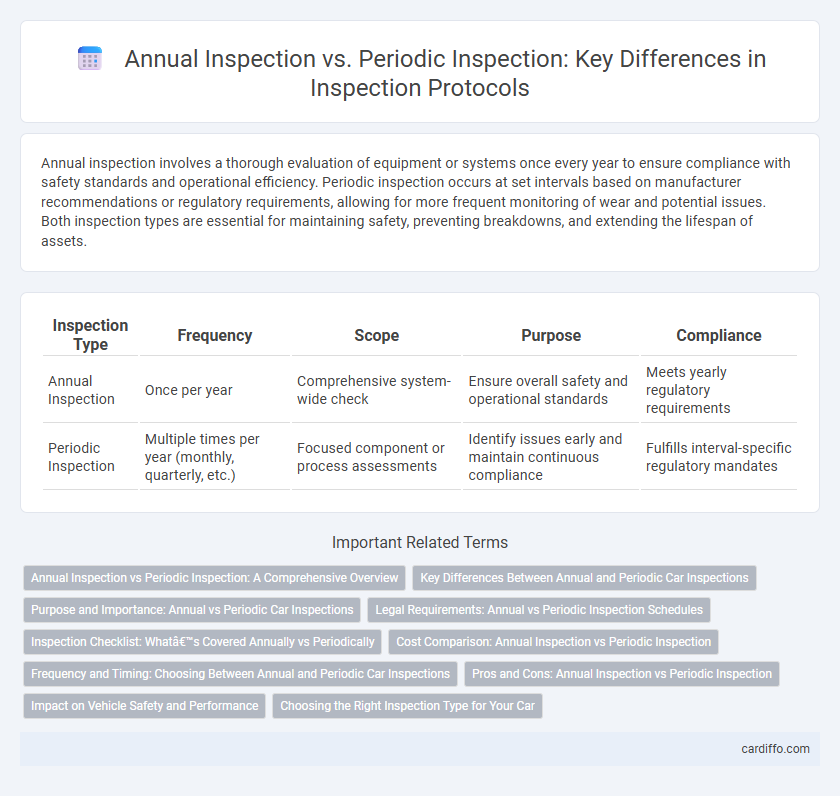Annual inspection involves a thorough evaluation of equipment or systems once every year to ensure compliance with safety standards and operational efficiency. Periodic inspection occurs at set intervals based on manufacturer recommendations or regulatory requirements, allowing for more frequent monitoring of wear and potential issues. Both inspection types are essential for maintaining safety, preventing breakdowns, and extending the lifespan of assets.
Table of Comparison
| Inspection Type | Frequency | Scope | Purpose | Compliance |
|---|---|---|---|---|
| Annual Inspection | Once per year | Comprehensive system-wide check | Ensure overall safety and operational standards | Meets yearly regulatory requirements |
| Periodic Inspection | Multiple times per year (monthly, quarterly, etc.) | Focused component or process assessments | Identify issues early and maintain continuous compliance | Fulfills interval-specific regulatory mandates |
Annual Inspection vs Periodic Inspection: A Comprehensive Overview
Annual inspection involves a thorough evaluation of equipment or property conducted once every year to ensure compliance with safety and operational standards. Periodic inspection refers to routine assessments performed at specified intervals shorter than a year, such as monthly or quarterly, to identify potential issues early and maintain continuous safety. Understanding the differences in scope, frequency, and regulatory requirements between annual and periodic inspections is essential for effective maintenance management and risk mitigation.
Key Differences Between Annual and Periodic Car Inspections
Annual inspections are comprehensive assessments required once a year to ensure a vehicle complies with safety and emission standards, covering critical systems like brakes, lights, and exhaust. Periodic inspections occur more frequently or at specific intervals, targeting specific components such as tire wear, fluid levels, or engine performance based on manufacturer guidelines or regulatory mandates. Key differences include the scope and frequency, with annual inspections providing a thorough overall evaluation while periodic inspections focus on ongoing maintenance to prevent issues.
Purpose and Importance: Annual vs Periodic Car Inspections
Annual car inspections ensure comprehensive evaluation of a vehicle's safety, emissions, and overall condition to comply with regulatory standards, reducing the risk of major failures. Periodic inspections focus on specific components or systems at scheduled intervals, targeting preventive maintenance and early detection of wear or defects. Both inspection types are essential for maintaining vehicle reliability, safety, and legal compliance, with annual inspections providing broad assurance and periodic inspections offering targeted, ongoing oversight.
Legal Requirements: Annual vs Periodic Inspection Schedules
Legal requirements for annual inspections mandate a comprehensive review within a 12-month cycle to ensure ongoing compliance and safety standards. Periodic inspections follow a legally defined timetable based on risk assessment, equipment type, or regulatory guidelines, potentially ranging from monthly to multi-year intervals. Regulatory bodies enforce these schedules to prevent violations, reduce liabilities, and maintain operational certification.
Inspection Checklist: What’s Covered Annually vs Periodically
Annual inspection checklists typically cover comprehensive safety systems, structural integrity, and critical equipment functionality to ensure long-term compliance and operational safety. Periodic inspections focus on specific components like HVAC filters, fire extinguishers, and electrical connections, addressing routine maintenance and detecting early wear or damage. Both inspection types emphasize detailed documentation and adherence to regulatory standards, optimizing facility reliability and safety.
Cost Comparison: Annual Inspection vs Periodic Inspection
Annual inspections generally incur higher upfront costs due to their frequency but can prevent costly repairs by identifying issues early, whereas periodic inspections tend to have lower immediate expenses but may lead to increased long-term maintenance costs from undetected problems. The cost efficiency of annual inspections is supported by reduced downtime and extended equipment lifespan, while periodic inspections might incur sporadic, unpredictable costs that affect budget planning. Selecting between annual and periodic inspection strategies depends on balancing inspection frequency with potential risk management and overall lifecycle expenses.
Frequency and Timing: Choosing Between Annual and Periodic Car Inspections
Annual inspections occur once every 12 months, ensuring comprehensive vehicle evaluation on a fixed yearly schedule. Periodic inspections take place at specific intervals determined by factors such as mileage, vehicle age, or regulatory requirements, offering more flexible timing. Selecting between annual and periodic car inspections depends on maintenance needs, legal mandates, and the vehicle's usage patterns for optimizing safety and compliance.
Pros and Cons: Annual Inspection vs Periodic Inspection
Annual inspection ensures comprehensive evaluation of equipment or systems once every year, providing detailed documentation and early detection of potential issues, but it may incur higher costs and operational downtime. Periodic inspection, conducted at shorter intervals based on usage or risk factors, allows for timely maintenance and reduces unexpected failures but might miss in-depth problem identification found in annual inspections. Choosing between annual and periodic inspections depends on balancing the thoroughness of yearly assessments against the flexibility and frequency of periodic checks to optimize safety and compliance.
Impact on Vehicle Safety and Performance
Annual inspections provide a comprehensive assessment of a vehicle's overall condition, identifying critical safety issues such as brake wear, tire integrity, and suspension problems that directly impact roadworthiness. Periodic inspections, conducted more frequently, help maintain optimal vehicle performance by addressing minor defects early, thus preventing major mechanical failures and ensuring consistent fuel efficiency. Both inspection types collectively enhance vehicle safety and longevity but differ in frequency and scope, with annual inspections focusing on thorough safety compliance and periodic inspections emphasizing ongoing performance monitoring.
Choosing the Right Inspection Type for Your Car
Annual inspections provide a comprehensive evaluation of your car's overall condition, focusing on safety and emissions to comply with regulatory standards. Periodic inspections target specific components like brakes, tires, and fluid levels at regular intervals to maintain optimal performance and prevent breakdowns. Selecting the right inspection type depends on your vehicle's age, usage, and local legal requirements to ensure roadworthiness and long-term reliability.
Annual inspection vs periodic inspection Infographic

 cardiffo.com
cardiffo.com